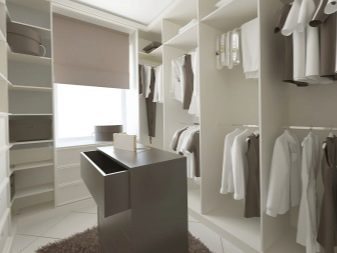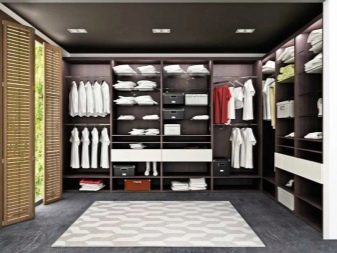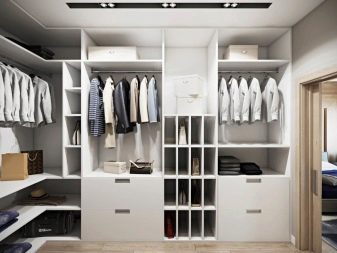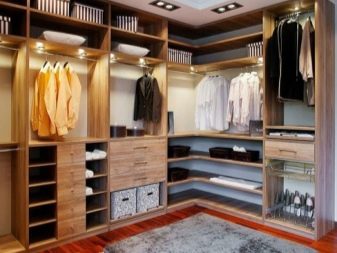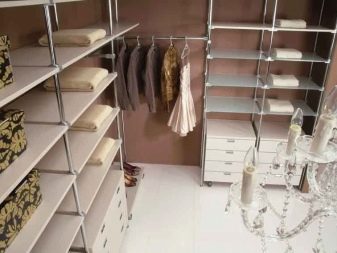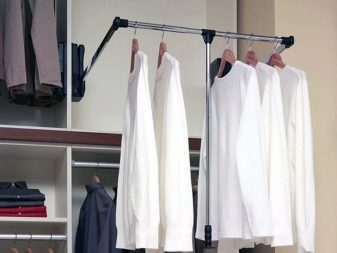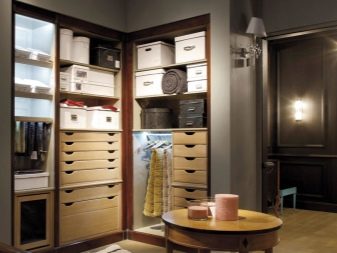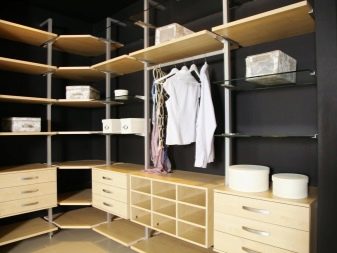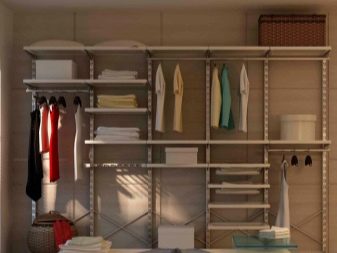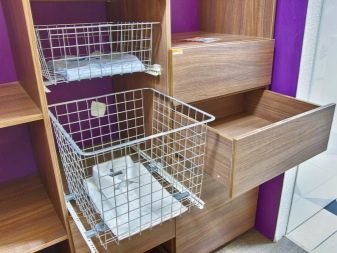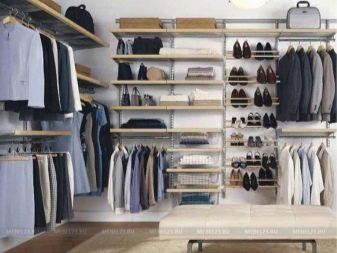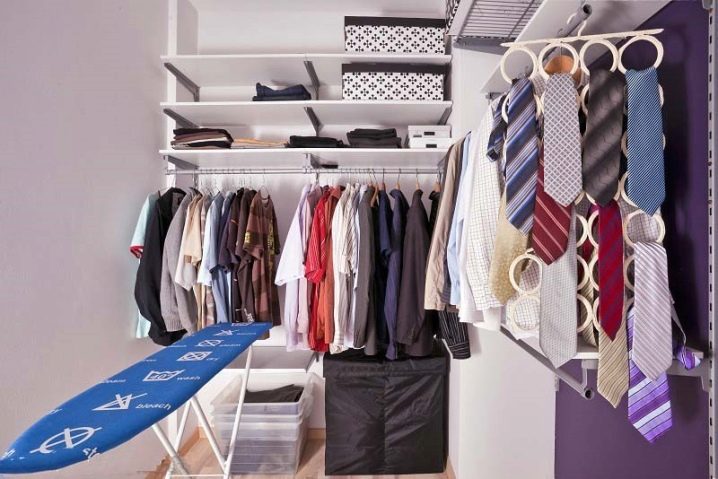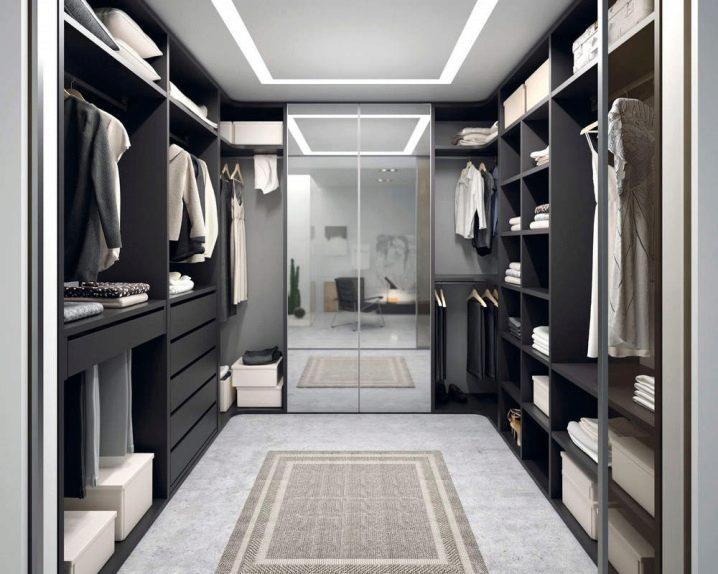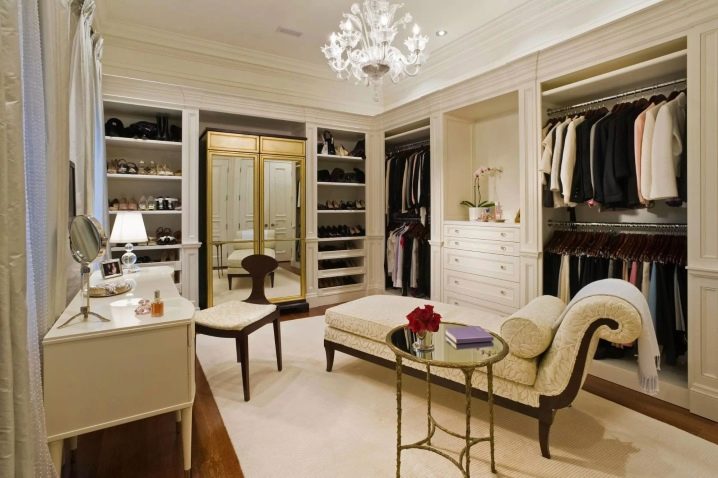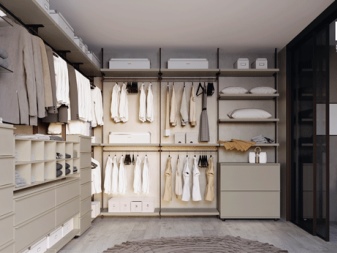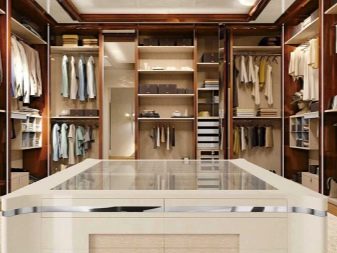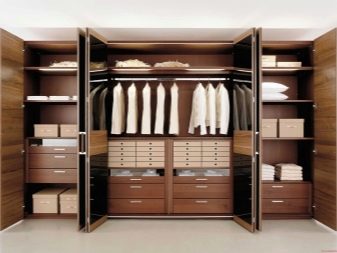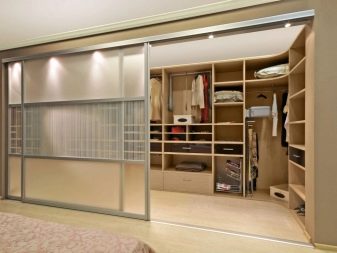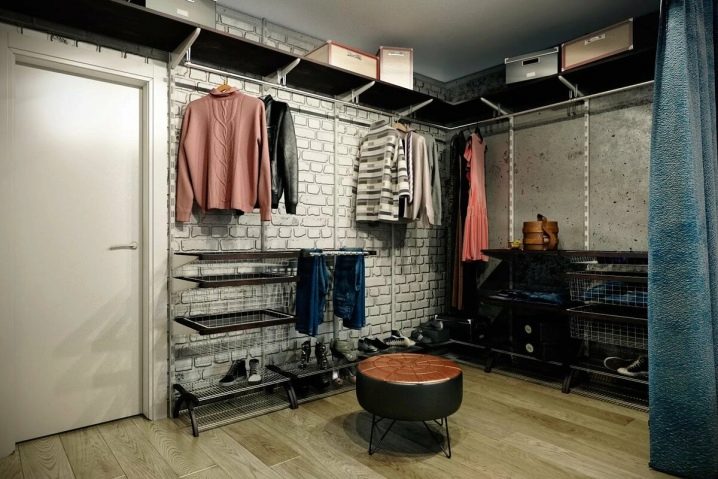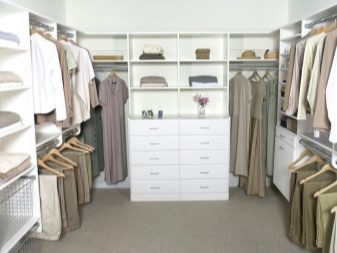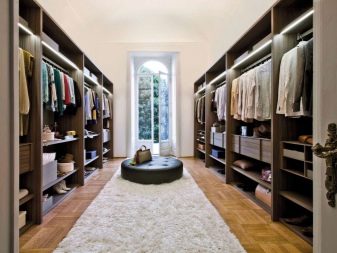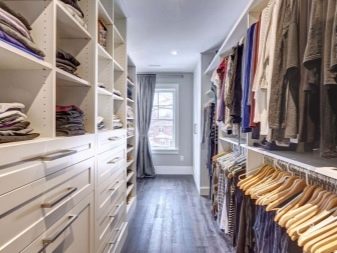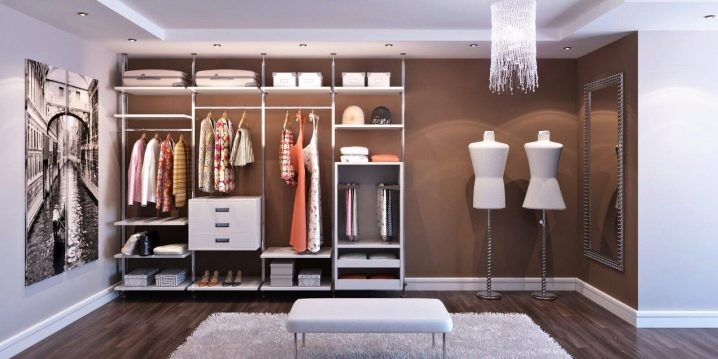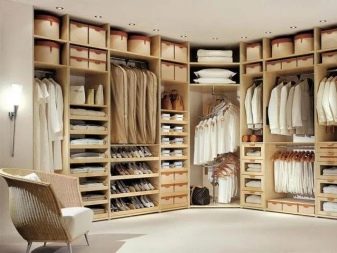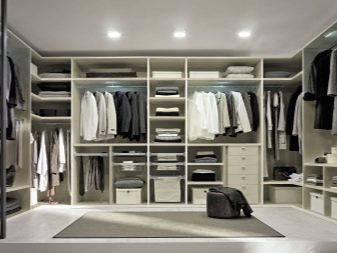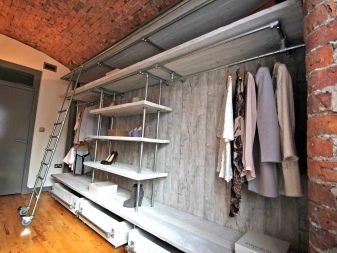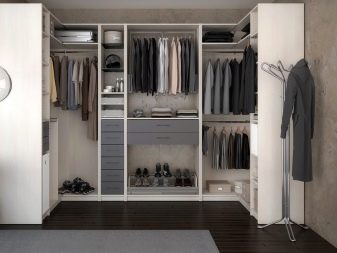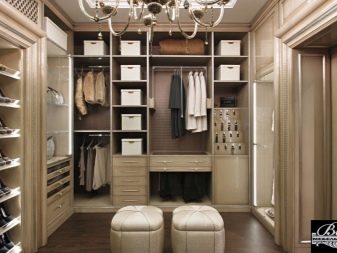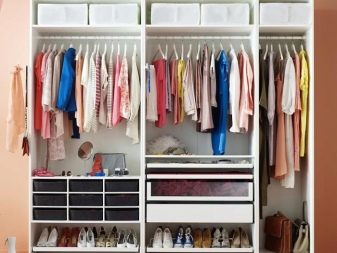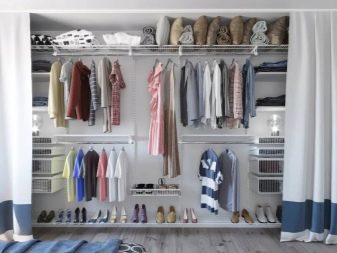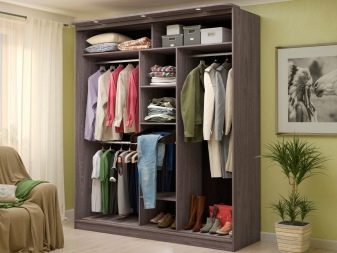Filling the dressing rooms
The dressing room is used for storing clothes, shoes and accessories. Competent filling with various compartments and systems helps to keep things in order and quickly pick up an image for any occasion. You can equip the dressing room with your own hands or use a ready-made solution.
Basic filling
Internal equipment depends on the needs of the owners. Some people need more hangers for office suits, while others need drawers for cotton clothes. However, there is a set of core modules that are usually installed internally. Such filling of the dressing room allows you to place things, shoes, all kinds of accessories.
Barbells
Do not hang clothes on hooks, as this can stretch them, lose their shape and look untidy. The best storage option is on hangers, which, in turn, are placed on rods. As a rule, these elements are metallic. The system usually provides one taller bar for long garments and several lower bar for shorter garments. Such modules can be located parallel or perpendicular to the wall, depending on the size of the available space.
Pantograph
By functional purpose this is the same as a barbell, only this device has a sliding mechanism that allows you to set the desired height. You can raise the pantograph and store longer clothing on it, or lower it to hang short items. Such a module is considered universal, in addition, it allows you to save a little space, so such a design is well suited for a small dressing room.
Hangers for trousers
They can be retractable or stationary, however, the height must be at least 60 cm... There are quite compact modules designed to store 5-7 pairs, as well as roomy ones, where you can hang more than two dozen trousers. In addition, it is worth providing hangers with tucks - they are usually used for everyday clothes, which must always be at hand and in the nearest access.
Boxes
Their presence allows you to conveniently place things and protect them from dust and dirt. In terms of format and purpose, the boxes can be different:
- large ones are usually designed for storing linen, home clothes or cotton products, bedding;
- small and flat, suitable for all kinds of accessories and ornaments.
If you need to keep a lot of small things in order, it is better to consider drawers with dividers. This will save you from problems when jewelry or ties are confused with each other, and you have to spend time getting them in proper shape. You can use models with a transparent wall - they allow you to immediately see where what lies, and not to arrange a long search when collecting.
Shelves
These modules are almost universal... They can be stationary or retractable. The width is at least 30-40 cm. Usually, deeper shelves are made on top, on the mezzanine, to store travel bags and large suitcases there, as well as other things that are rarely used in everyday life. In this case, the depth should not be more than 100 cm, otherwise inconveniences may arise.
Baskets
Some things do not require ironing or special storage conditions. Such clothes can be folded into baskets - they are plastic, wicker, fabric and wooden, so it is easy to choose a model that will fit into the dressing room. It is better to choose products with tight lids to avoid dust ingress. For convenience, you can stick stickers on the surface with inscriptions or images of things that lie there in order to quickly navigate.
The basket is also suitable for storing dirty items that are waiting to be washed. In this case, you should choose a light model so that you can easily bring it to the machine with all the contents.
Shoe modular systems
Many people store boots and shoes in boxes, but if you decide to start organizing a dressing room, then there is a better option. This is a system with multi-tiered shelves, straight and inclined, where you can arrange different types of shoes in a convenient order. For boots with long shanks, special clamps are provided to better maintain their shape. Such a system not only maintains order, but also makes it possible to keep shoes in front of your eyes, which is convenient when you need to choose a pair for a particular look.
Hangers
They can be of different types. Some are intended for clothing, others are used for accessories - ties, scarves, belts. There are hangers that are placed on rods or pantographs, as well as circular models - they are placed in the corner of the room.
Hooks or Clips
They can be installed on a free wall or even on a cabinet door if there is not a lot of space. These elements are usually used to secure small accessories and ornaments. The hooks are also suitable for umbrellas.
Additional elements
Other items and systems for various purposes can also be provided in the dressing room.
- Mirrors... It is difficult to do without them if you are going somewhere. It is recommended to install a large growth mirror so that you can fully appreciate your appearance. Small models are also useful - they are often used when applying makeup or choosing jewelry.
- Dressing table and armchair. Additional furniture will make the dressing room more comfortable. If there is not much space, instead of a table, you can use a narrow console and a small ottoman.
- Section for household equipment. In the dressing room, you can store an ironing board, iron, steamer - this will allow you to have all the necessary tools at hand and quickly put your clothes in order.
Competent ergonomics
The wardrobe in the apartment can be equipped with your own hands. If you do not have too much free space, then the simplest option is suitable - a wardrobe containing all the necessary filling. Inside it, you can equip various compartments and shelves, drawers, rods and hangers, without having to allocate a separate room. Such a wardrobe can be placed in the bedroom, and the space next to it can be fenced off with a screen or curtain, so that it is more comfortable to change clothes.
Inside, there are usually several zones, along which things are distributed.
- Middle department. This is the main part where clothes and other accessories for every day are located. There may be shelves, drawers, and a bar to accommodate various wardrobe items.
- Upper section. There are usually rarely used items, hats or bed linen. It can be either a solid mezzanine or several shelves of different heights.
- Lower section. Designed for shoes. This area may contain boxes and more spacious shelves for winter boots.
If the size of the room allows, then you can install an elongated cabinet along the wall. A corner model is better suited for a small bedroom. It also has good roominess while saving space.
Owners of private houses or more spacious apartments can afford to allocate a separate room for a dressing room. Sometimes it is immediately provided for in the developer's project, but often the owners remake an attic or a storage room of 4 or 6 square meters for these needs. m.
There are three ways to organize your space.
- Using a hull design... The system resembles the same wardrobe, only in this case more variety is available due to the availability of free space. Additional drawers, shelves and compartments can be installed.
- Mesh modular designs. They consist of vertical slats to which other elements are attached - rods, boxes, baskets. The main advantage of such a system is transparency, you can immediately see where what lies. In addition, the structure is easily disassembled, its parts can be removed or changed in places, if necessary.
- Loft style. It is an open system that rests on metal racks. Bars and shelves are attached to them. Drawers and baskets are also used, but in small quantities, since the style implies an abundance of free space.
Closed cabinet furniture protects well from dust, but takes up more space than other systems. Metal structures are lighter and more mobile, but they need to be kept in perfect order with them.
The interior arrangement of the dressing room can be different, there are several layouts of furniture and other modules.
- U-shaped. All items are placed along three walls. If there is enough space, then such an arrangement allows you to properly organize the wardrobe - everything you need will be within reach, you will not have to reach far for things.
- Parallel... Shelves and cabinets are placed opposite each other. This option can be used if there is a small window on one of the walls.
- Corner or L-shaped. The system is mounted at the junction of two walls. This saves space.
- Linear... Cabinets and modules are located along one wall. Suitable for very narrow spaces.
When planning, it is worth considering the needs of all family members if the dressing room is shared. Someone may need more space.
It is also better to allocate a separate area for each family member. This will avoid clothing confusion.
Ventilation and lighting
In addition to organizing storage systems, there are other important points. Do not forget about ventilation, because due to stale air or high humidity, things can deteriorate, especially capricious natural materials suffer. The easiest option is to make the ventilation valves yourself by drilling holes and installing plugs. It is also possible to install a more complex system with automatic ventilation.
Lighting plays an equally important role. Most often, there are no windows in the dressing room, so natural light does not get there. Taking this into account, it is not worth saving on lamps - due to insufficient light, vision suffers, in addition, this can create a distorted perception of colors, which, when choosing an outfit, will interfere with correctly assessing the image.
It is better to install not only general lighting on the ceiling, but also local lamps next to the mirror and near the shelves. The light control system and dimmers can be used to dim and turn on individual lamps as needed.
Overview of examples
For inspiration, you can use ready-made solutions. They will tell you how to equip a dressing room so that the room is ergonomic and comfortable. Below are also options with wardrobes for small apartments, where it is not possible to allocate a separate room.
- This is an open loft style wardrobe system. It is quite easy to assemble and, if necessary, disassembled. Includes bars, hangers, drawers, shoe storage and an upper mezzanine for boxes. With the help of such modules, you can equip a wardrobe in a small room, and will complement it with a growth mirror. A similar system is designed for 1-2 people.
- This dressing room is suitable for the whole family or for people who have a lot of clothes.... There is a large number of storage systems inside. Here, case boxes and mesh modules are combined - this is a good solution, so the structure does not look too heavy and takes up less space.
- Another option for a spacious dressing room, however, in this case, cabinet furniture was used... Such an environment can fit into both classic and modern styles. Inside there are not only storage systems, but also a large mirror, as well as ottomans for convenience.
- Completing a mini-dressing room for those who do not have a separate room. The storage system is installed along one wall of the bedroom. Everything you need to keep your clothes and shoes in order is provided here. The structure is separated from the main space with a curtain.
- This is a corner cabinet system that can be installed right in the bedroom. The filling allows you to place different types of clothes and shoes.
You can mount sliding doors or use a curtain or screen to cover the structure.
- This is what a wardrobe looks like, which is also suitable for a small bedroom.... Inside it is a mini-dressing room with sections for outerwear, pull-out hangers, a place for shoes and a mezzanine.

